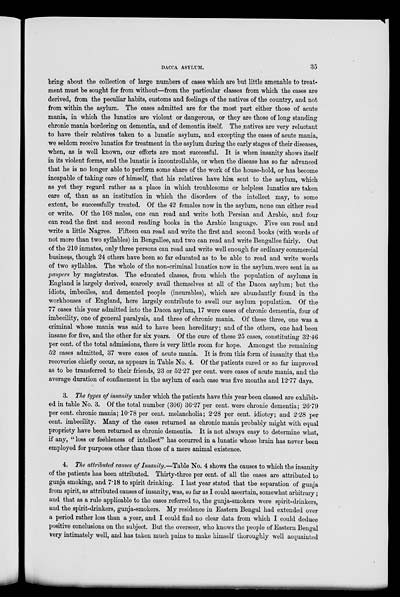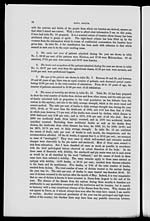Medicine - Mental health > 1867-1924 - Annual report of the insane asylums in Bengal > Insane asylums in Bengal annual reports 1867-1875 > Annual report on the insane asylums in Bengal, for the year 1870
(341) Page 35
Download files
Individual page:
Thumbnail gallery: Grid view | List view

DACCA ASYLUM. 35
bring about the collection of large numbers of cases which are but little amenable to treat-
ment must be sought for from without—from the particular classes from which the cases are
derived, from the peculiar habits, customs and feelings of the natives of the country, and not
from within the asylum. The cases admitted are for the most part either those of acute
mania, in which the lunatics are violent or dangerous, or they are those of long standing
chronic mania bordering on dementia, and of dementia itself. The natives are very reluctant
to have their relatives taken to a lunatic asylum, and excepting the cases of acute mania,
we seldom receive lunatics for treatment in the asylum during the early stages of their diseases,
when, as is well known, our efforts are most successful. It is when insanity shows itself
in its violent forms, and the lunatic is incontrollable, or when the disease has so far advanced
that he is no longer able to perform some share of the work of the house-hold, or has become
incapable of taking care of himself, that his relatives have him sent to the asylum, which
as yet they regard rather as a place in which troublesome or helpless lunatics are taken
care of, than as an institution in which the disorders of the intellect may, to some
extent, be successfully treated. Of the 42 females now in the asylum, none can either read
or write. Of the 168 males, one can read and write both Persian and Arabic, and four
can read the first and second reading books in the Arabic language. Five can read and
write a little Nagree. Fifteen can read and write the first and second books (with words of
not more than two syllables) in Bengallee, and two can read and write Bengallee fairly. Out
of the 210 inmates, only three persons can read and write well enough for ordinary commercial
business, though 24 others have been so far educated as to be able to read and write words
of two syllables. The whole of the non-criminal lunatics now in the asylum were sent in as
paupers by magistrates. The educated classes, from which the population of asylums in
England is largely derived, scarcely avail themselves at all of the Dacca asylum; but the
idiots, imbeciles, and demented people (incurables), which are abundantly found in the
workhouses of England, here largely contribute to swell our asylum population. Of the
77 cases this year admitted into the Dacca asylum, 17 were cases of chronic dementia, four of
imbecility, one of general paralysis, and three of chronic mania. Of these three, one was a
criminal whose mania was said to have been hereditary; and of the others, one had been
insane for five, and the other for six years. Of the cure of these 25 cases, constituting 32.46
per cent. of the total admissions, there is very little room for hope. Amongst the remaining
52 cases admitted, 37 were cases of acute mania. It is from this form of insanity that the
recoveries chiefly occur, as appears in Table No. 4. Of the patients cured or so far improved
as to be transferred to their friends, 23 or 52.27 per cent. were cases of acute mania, and the
average duration of confinement in the asylum of each case was five months and 12.77 days.
3. The types of insanity under which the patients have this year been classed are exhibit-
ed in table No. 3. Of the total number (306) 36.27 per cent. were chronic dementia; 26.79
per cent. chronic mania; 10.78 per cent. melancholia; 2.28 per cent. idiotcy; and 2.28 per
cent. imbecility. Many of the cases returned as chronic mania probably might with equal
propriety have been returned as chronic dementia. It is not always easy to determine what,
if any, " loss or feebleness of intellect" has occurred in a lunatic whose brain has never been
employed for purposes other than those of a mere animal existence.
4. The attributed causes of Insanity.—Table No. 4 shows the causes to which the insanity
of the patients has been attributed. Thirty-three per cent. of all the cases are attributed to
gunja smoking, and 7.18 to spirit drinking. I last year stated that the separation of gunja
from spirit, as attributed causes of insanity, was, so far as I could ascertain, somewhat arbitrary;
and that as a rule applicable to the cases referred to, the gunja-smokers were spirit-drinkers,
and the spirit-drinkers, gunja-smokers. My residence in Eastern Bengal had extended over
a period rather less than a year, and I could find no clear data from which I could deduce
positive conclusions on the subject. But the overseer, who knows the people of Eastern Bengal
very intimately well, and has taken much pains to make himself thoroughly well acquainted
Set display mode to: Large image | Zoom image | Transcription
Images and transcriptions on this page, including medium image downloads, may be used under the Creative Commons Attribution 4.0 International Licence unless otherwise stated. ![]()
| Permanent URL | https://digital.nls.uk/83379029 |
|---|



![[Page 34]](https://deriv.nls.uk/dcn4/8337/83379028.4.jpg)
